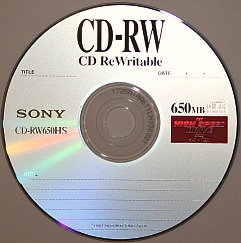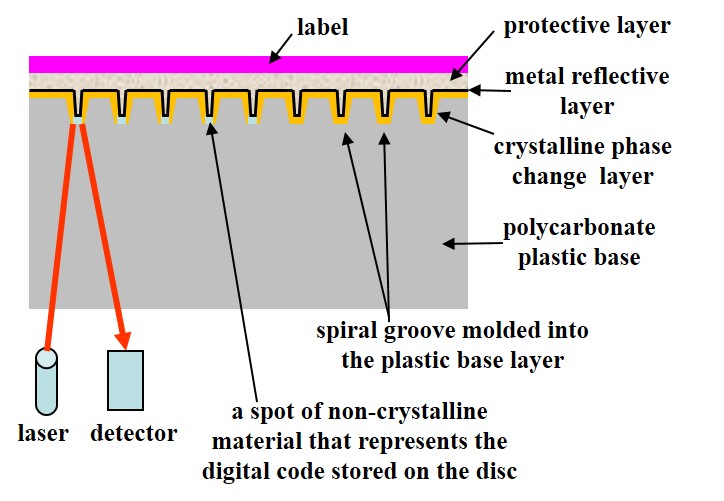CD RW or CD ERASABLE MEDIA
CD RW discs are erasable or rewriteable optical disc media in the CD size format. This disc format is purchased blank and then users can add information to the CD-RW media. The advantage of this media is that it can be erased and reused.
SEARCH FOR RECORDABLE DVD MEDIA
The disadvantage is that in general the whole disc needs to be erased in order to add more information to the disc. However, certain burning software will allow the addition of more files or deletion of individual files without removing all of the previously stored information. This may or may not work well, but usually is not the way this format is used.
Capacity and Recording Speeds

The erasable CD comes in two storage capacities of 650 MB initially, but now most CD RWs have a capacity of 700 MB.
The recording speed of the media varies depending on the age of the disc. The first CD-RWs had a recording speed of 1x to 4x. These were categorized as slow recording discs. As the technology progressed, faster recording speeds for erasable media were achieved. The next class to be introduced was the High Speed CD-RW, which possessed a recording speed range of 4x to 10x or sometimes 4x to 12x. Next came the Ultra High Speed erasable CD, which had a recording speed range of 16x to 24x. Finally, the Ultra High Speed Plus (+) disc provided recording speeds of 32x. The Ultra High Speed and the Ultra High Speed Plus discs were not as popular or common as the High Speed version. This was because of compatibility issues between the Ultra High Speed media and recorders and because by the time these discs were introduced, other types of removable media were being used instead of CDs.
Note that in order to record High Speed and Ultra High Speed CD-RWs, the drive must have the Ultra High Speed logo on the faceplate of the drive as shown in the image below. Without this logo, it is likely that the drive is meant only to be used to record the low speed discs.

CD RW Base and Phase Change Recording Layer
The a cross-section of the rewriteable CD structure is shown in the picture below. This disc format consists of a polycarbonate plastic base with a spiral groove molded into the top surface of the polycarbonate. This is similar to the CD-R disc.
Next there is a phase change layer that is sandwiched between two other layers called di-electric layers, which assist in the proper functioning of the phase change layer. These layers are not shown in the picture and do not exist when comparing this disc to the CD-R. The phase change layer is where the digital information is stored. In read-only CDs, the digital information is represented by pits in the plastic base and for CD-Rs it is spots in the dye layer.

For CD RW media, the phase change layer is in a crystalline form when blank. When information is being recorded to this media, the recording laser heats the phase change layer to a high enough temperature to convert the crystalline material to a non-crystalline or amorphous state. Therefore, within the spiral groove there are small spots of amorphous material, which represent the digitally stored information, mixed in with crystalline regions that have not been altered by the laser light. To erase the disc, the laser heats the amorphous regions to a temperature that makes the spots turn crystalline again and indistinguishable from the rest of the disc. There is a limit as to how many times this can be done effectively, but this limit is not normally reached in typical use situations.
Erasable CD Metal Reflective Layer and Labeling
Like other CDs, the next layer in CD RW erasable media that resides on top of the three layers mentioned above is a metal reflective layer. In this case it is aluminum or aluminum alloy. Next, a protective layer is placed on top of the metal and then a label. Sometimes the disc has no labeling to indicate that it is an erasable disc. An erasable disc has a greyish appearance when observed from the base side. This grey appearance is significantly different than the greens and blues encountered with CD-Rs and all erasable CD media pretty much look the same in terms of color.
CD-RW Longevity
Erasable CDs are not suitable for the long term storage of information as these discs have shown lower stability than the CD-Rs, which use a gold metal layer and stable dye. A rough lifetime range, based on relative stability studies, is 20 to 50 years average if the discs are stored under recommended conditions. Most of the discs will be in the upper end of this longevity range. In addition, these discs can be erased or altered and therefore, the information stored on the disc can be changed.
Therefore, CD RWs are not recommended for digital scrapbooking storage. The primary intent of this format is to move files around from one computer to another or person to person. When used in this fashion the format is acceptable for everyday use.